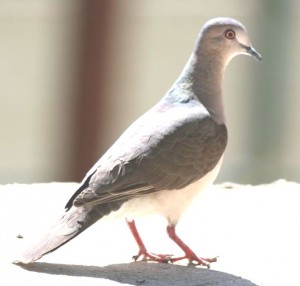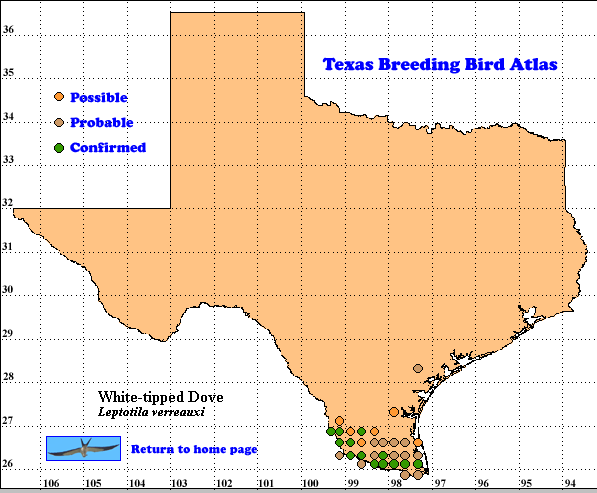White-tipped Dove, formerly White-fronted Dove, is most easily identified by its distinctive call, described as similar to the sound of a person blowing over the mouth of a bottle. This large dove feed on seeds and berries on or near the ground and close to cover. Its head bobs when it walks, giving it a mechanical appearance. Like many other primarily tropical species little is known about the life history of this dove and the other 10 or more members of its genus. Much of what is known comes from the work of Alexander Skutch in Costa Rica on a different subspecies (possibly a different species) than White-tipped Doves in Texas (Hogan 1999).
DISTRIBUTION. During the 1987-1992 field work seasons of the TBBA project, observers found 22 confirmed breeding sites, 44 probable sites and 32 possible sites for White-tipped Doves, almost all below the 27th parallel. The few summer and breeding symbols on Oberholser’s (1974) map are all relatively close to the Rio Grande River, suggesting a larger population and an expanded range in 1987-1992, compared to the pre-1974 period.
These doves are also resident in much of Mexico and Central America, as well as South America from Colombia to Peru and from the north coast and nearby islands to northern Argentina (Howell and Webb 1995, Am. Ornithol. Union 1998, Hogan 1999).
SEASONAL OCCURRENCE. White-tipped Doves are resident in Texas, breeding from early February to mid August, based on egg dates from February 13 to July 25 (Oberholser 1974).
BREEDING HABITAT .In Texas White-tipped Doves breed from near sea level to about 1200 m (4000 ft; Oberholser 1974). Originally restricted to dense riparian forests along the Rio Grande River, these doves adapted to citrus groves and suburban yards and parks with the clearance of riparian forests for agriculture. In native vegetation these doves prefer to place their nests in the dense interior of Texas ebony or Celtis spp. shrubs at a height of about 2 m (7ft; Hogan 1999).
Nest construction may vary, perhaps geographically; some are apparently typical loosely built dove nests, others more substantial. In the shallow bowl the female typically lays 2 creamy-buff, unmarked eggs which both parents incubate for 14 days. Young birds leave the nest 12-15 days after hatching . Usually only one brood is raised per year (Harrison 1979, Hogan 1999).
STATUS. The map in Oberholser (1974) indicates a much smaller range for this species than shown on the TBBA map below. Lockwood and Freeman (2004) describe further rang expansion since 1992 and consider this species a common resident in its range.
Text by Robert C. Tweit (2007)
Literature cited.
American Ornithologists’ Union. 1998. Checklist of North American birds, 7th ed. Am, Ornithol. Union, Washington, DC.
Harrison, H. H. 1979. A field guide to western birds’ nests. Houghton Mifflin, Boston, MA.
Hogan, K. M. 1999. White-tipped Dove (Leptotila verreauxi). In The birds of North America, No. 436 (A. Poole and F. Gill, eds.). The Birds of North America, Inc., Philadelphia, PA.
Howell, S. N. G. and S. Webb. 1995. A guide to the birds of Mexico and northern Central America. Oxford University Press, New York.
Lockwood, M. W. and B. Freeman. 2004. The TOS handbook of Texas birds. Texas A&M University Press, College Station.
Oberholser, H. C. 1974. The bird life of Texas, University of Texas Press, Austin.

